Olive Oil Market Research, 2032
The global olive oil market size was valued at $18.6 billion in 2022, and is projected to reach $30.2 billion by 2032, growing at a CAGR of 5.2% from 2023 to 2032.
Olive oil is a versatile, liquid fat extracted from pressed olives, primarily cultivated in Mediterranean regions. A fundamental component of Mediterranean cuisine, it boasts a rich history dating back millennia. Renowned for its health benefits, olive oil is rich in monounsaturated fats, antioxidants, and anti-inflammatory properties. Its diverse uses span culinary applications, where it enhances flavors in salads, sautés, and dressings. In addition, olive oil is a key ingredient in skincare and haircare, valued for moisturizing and nourishing properties. Its robust taste profile, ranging from delicate to robust, adds depth to dishes and exemplifies its status as a culinary and cultural cornerstone.
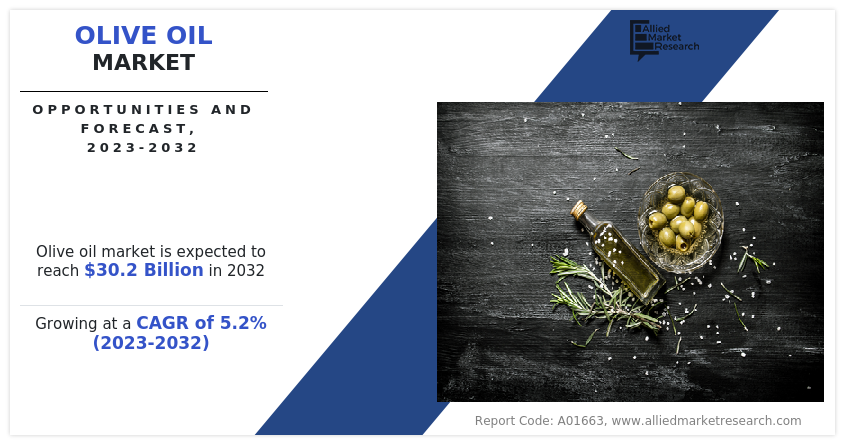
Market Dynamics
The restaurant and culinary industry has a profound influence on the olive oil industry, significantly driving consumer demand. As renowned chefs and culinary experts increasingly integrate olive oil into their recipes, it elevates the ingredient's status as a culinary essential. High-profile restaurants showcasing olive oil in diverse dishes contribute to the oil's popularity and set culinary trends that resonate with consumers. Its versatility allows chefs to use it in various cooking methods, from sautéing and frying to drizzling over salads, enhancing flavors, and promoting healthier cooking practices. As diners savor these creations, they develop an affinity for olive oil, prompting them to seek out and incorporate it into their home kitchens. Moreover, the culinary industry emphasizes health-conscious and gourmet dining experiences further propel the demand for premium olive oil products. As restaurants prioritize high-quality ingredients, including extra virgin olive oil, consumers associate these culinary choices with elevated taste and health benefits. The influence extends beyond the dining table, as consumers are inspired to replicate these experiences in their homes. This culinary influence, combined with the broader movement toward healthier dietary choices, contributes to a sustained surge in olive oil market demand, making it a kitchen staple as a symbol of culinary sophistication & well-being.
In addition, the surge in the Mediterranean diet trend boosts the demand for olive oil. This renowned dietary pattern, inspired by the traditional eating habits of Mediterranean countries, places a strong emphasis on the consumption of olive oil as a primary source of dietary fat. With a focus on heart-healthy and nutrient-rich foods, the Mediterranean diet positions olive oil as a staple ingredient, contributing to its rising popularity worldwide. As consumers increasingly adopt this dietary approach for its associated health benefits, the demand for olive oil experiences a significant upswing, driven by its integral role in achieving the authentic flavors and nutritional balance, which is characteristic of Mediterranean cuisine. Furthermore, the Mediterranean diet trend extends beyond individual dietary choices to influence broader culinary and lifestyle preferences. As health-conscious consumers seek ways to incorporate elements of this iconic diet into their daily lives, olive oil emerges as a versatile and flavorful solution. Its use in salad dressings, marinades, and cooking aligns seamlessly with the Mediterranean culinary tradition, fostering a sustained and growing market demand for olive oil. The diet has an association with reduced cardiovascular risks and overall well-being that further amplifies olive oil's demand, making it a go-to-choice for consumers aiming to embrace a healthier lifestyle inspired by the Mediterranean culinary heritage.
Furthermore, the surge in the demand for olive oil can be attributed to the growing awareness of its health benefits. In a time where people are increasingly mindful of their well-being, there is a noticeable shift toward choosing cooking oils that contribute positively to health. Olive oil, known for its heart-friendly attributes and abundant antioxidants, has become a top choice for those seeking to make healthier dietary choices. Its adaptability and favorable nutritional profile make it a staple in contemporary kitchens, particularly as consumers prioritize ingredients that align with their overall health objectives. The widespread popularity of olive oil is also heightened by its association with the Mediterranean diet, a dietary regimen renowned for promoting longevity and robust health. As individuals place a premium on nutritious and functional foods, olive oil emerges as a standout ingredient that not only enhances the taste of dishes but also supports a health-conscious lifestyle. This trend is anticipated to endure, reflecting a broader recognition of the significant role that olive oil plays in crafting meals that are both delectable and health focused.
Moreover, the expanding global appreciation for diverse flavors has significantly fueled the demand for olive oil market. As people worldwide embrace a more diverse range of culinary experiences, there is a growing interest in incorporating unique and authentic ingredients into their cooking. Olive oil, with its distinctive taste and versatility, has become a prominent choice in this global culinary shift. Its capacity to enhance a variety of international dishes makes it a sought-after cooking and finishing oil, resonating with consumers who value genuine and distinct flavors. Furthermore, the increased cross-cultural exchange, facilitated by globalization, has introduced consumers to the Mediterranean diet, in which olive oil plays a central role. The rise in awareness and admiration for this diet, known for its health benefits and flavorful offerings, has significantly contributed to the increasing olive oil market demand worldwide. As people develop a liking for the diverse and nuanced tastes associated with olive oil, its popularity continues to grow, transcending cultural boundaries to establish itself as a kitchen essential on a global scale. The globalization of taste preferences has thus become a key factor propelling the sustained and expanding market demand for olive oil, reflecting a broader culinary appreciation for this iconic ingredient.
However, the limited geographical distribution of olive trees poses a significant restraint on the olive oil market growth, influencing both supply and demand dynamics. Olive trees flourish in regions with Mediterranean climates, characterized by mild, rainy winters and hot, dry summers. This geographical specificity creates a concentration of olive oil production in certain areas, making the industry susceptible to environmental challenges, such as droughts or unexpected weather events. As a result, any disruptions in these key growing regions can have a substantial impact on olive oil supplies, leading to fluctuations in availability and potentially causing price volatility. Moreover, the limited geographical distribution restricts the potential for expansion and diversification of olive oil production into non-Mediterranean regions. While efforts are underway to cultivate olive trees in new areas, the unique climate requirements make large-scale cultivation challenging. This limitation, combined with the increasing global demand for olive oil, can create a scenario where supply struggles to meet the growing market needs. Consequently, the constrained geographical distribution not only affects the resilience of the olive oil market but also underscores the importance of sustainable practices and innovative solutions to mitigate the risks associated with this inherent restraint.
Segment Overview:
The olive oil market forecast is segmented into type, application, distribution channel, and region. By type, the market is divided into refined, virgin, extra virgin, and others. By application, the market is classified into food & beverage, personal care, and cosmetics. pharmaceuticals, and others. By distribution channel, the market is classified into hypermarkets/supermarkets, departmental stores, online retail, and medical stores. Region-wise, olive oil market share is analyzed across North America (U.S., Canada, Mexico), Europe (UK, Germany, France, Italy, Spain, and Rest of Europe), Asia-Pacific (China, Japan, India, Australia, Indonesia, and Rest of Asia-Pacific), LAMEA.
By type, the olive oil market analysis is classified into refined, virgin, extra virgin, and others. The refined segment accounted for a major share of the olive oil market in 2022 and is expected to grow at a significant CAGR during the forecast period. The demand for the refined segment of olive oil is rising due to its neutral flavor profile and higher smoke point compared to extra virgin olive oil. Refined olive oil undergoes a more extensive filtration process, removing impurities and enhancing stability during cooking. This makes it suitable for a variety of culinary applications, including frying and high-heat cooking, where the higher smoke point prevents the oil from breaking down. The refined olive oil's versatility and cost-effectiveness attract consumers seeking a cooking oil with a milder taste and optimal performance in diverse cooking methods.
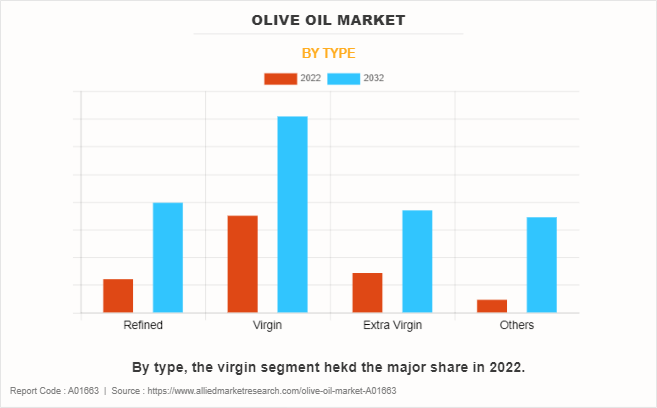
By application, the market is classified into food & beverage, personal care, and cosmetics. pharmaceuticals, and others. The others segment accounted for a major olive oil market share in 2022 and is expected to grow at a significant CAGR during the forecast period.
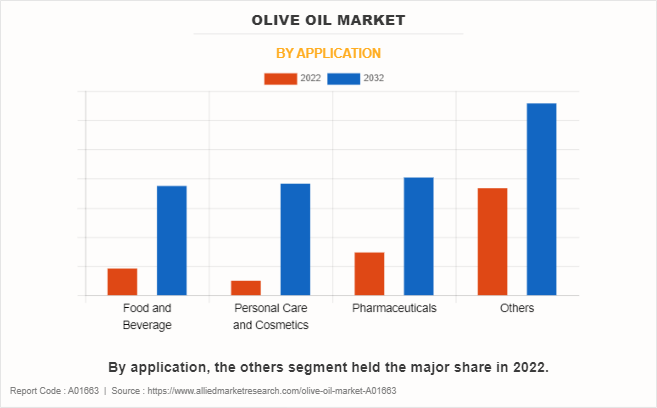
By distribution channel, the olive oil market size is classified into hypermarkets/supermarkets, departmental stores, online retail, and medical stores. The hypermarkets/supermarkets segment accounted for a major share of the olive oil market in 2022 and is expected to grow at a significant CAGR during the forecast period. The demand for olive oil in the hypermarkets/supermarkets segment is rising due to several factors. These retail outlets offer a wide variety of olive oil brands and types, providing consumers with extensive choices. The convenience of one-stop shopping, promotional activities, and the ability to compare products easily contribute to the popularity of hypermarkets/supermarkets. In addition, these large-scale retailers often provide attractive discounts and promotional offers, attracting cost-conscious consumers. The visibility of olive oil products in well-organized and easily accessible sections within these stores further enhances consumer awareness and drives increased sales.
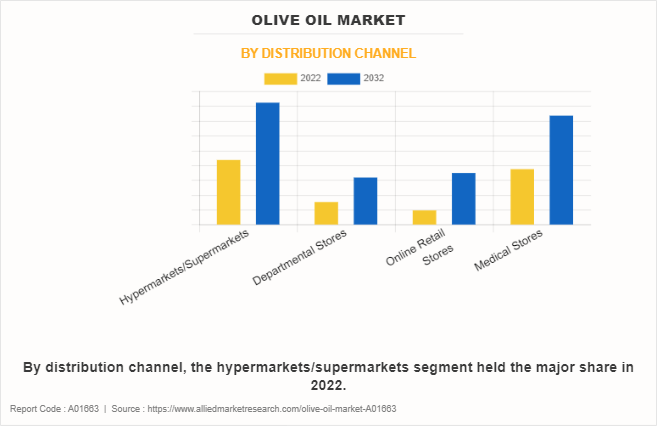
By region, the olive oil market is analyzed across North America (U.S., Canada, Mexico), Europe (UK, Germany, France, Italy, Spain, and Rest of Europe), Asia-Pacific (China, Japan, India, Australia, Indonesia, and Rest of Asia-Pacific), LA and MEA. The Europe region accounted for a major share of the olive oil market in 2022 and is expected to grow at a significant CAGR during the forecast period. The demand for olive oil in Europe is rising due to several factors. Firstly, the Mediterranean diet, rich in olive oil, is widely embraced in European countries, contributing to its staple use in cooking. In addition, growing health consciousness has led consumers to prefer healthier cooking oils like olive oil. The culinary traditions deeply rooted in European culture also play a role, as olive oil is a key ingredient in various regional dishes. The popularity of Mediterranean cuisine, lifestyle choices, and increased awareness of the health benefits associated with olive oil continue to drive its demand in the European market.
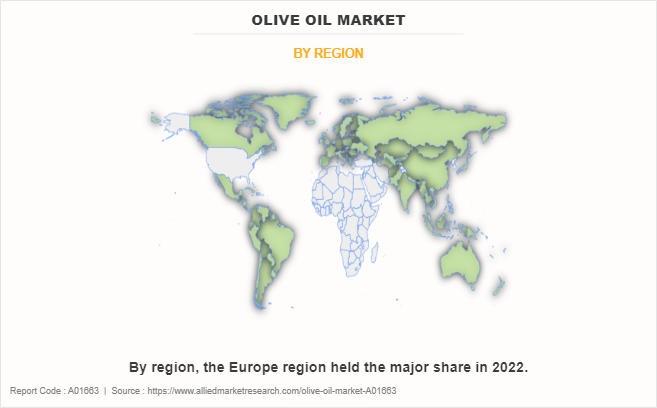
Competitive Landscape:
The major players operating in the olive oil industry focus on key market strategies, such as mergers, product launches, acquisitions, collaborations, and partnerships. They have been also focusing on strengthening their market reach to maintain their goodwill in the ever-competitive market. Some of the key players in the olive oil market include Deoleo, SOVENA, GRUPPO SALOV, Del Monte Foods Private Limited, California Olive Ranch, Inc., Borges INTERNATIONAL GROUP, S.L.U., POMPEIAN, Cargill, Conagra Brands, and Modi Naturals Ltd.
Key Benefits for Stakeholders
- This report provides a quantitative analysis of the market segments, current trends, estimations, and dynamics of the olive oil market analysis from 2022 to 2032 to identify the prevailing olive oil market opportunities.
- The market research is offered along with information related to key drivers, restraints, and opportunities.
- Porter's five forces analysis highlights the potency of buyers and suppliers to enable stakeholders make profit-oriented business decisions and strengthen their supplier-buyer network.
- In-depth analysis of the olive oil market segmentation assists to determine the prevailing market opportunities.
- Major countries in each region are mapped according to their revenue contribution to the global market.
- Market player positioning facilitates benchmarking and provides a clear understanding of the present position of the market players.
- The report includes the analysis of the regional as well as global olive oil market trends, key players, market segments, application areas, and market growth strategies.
Olive Oil Market Report Highlights
| Aspects | Details |
| Forecast period | 2022 - 2032 |
| Report Pages | 444 |
| By Distribution Channel |
|
| By Type |
|
| By Application |
|
| By Region |
|
| Key Market Players | Deoleo, SOVENA, GRUPPO SALOV, Cargill, POMPEIAN, California Olive Ranch, Inc., Del Monte Foods Private Limited, Borges INTERNATIONAL GROUP, Modi Naturals Ltd, Conagra Brands |
Analyst Review
According to the insights of the CXOs, the global olive oil market is expected to witness robust growth during the forecast period. The olive oil market reflects a dynamic landscape characterized by a convergence of culinary, health, and cultural influences. With its roots deeply embedded in Mediterranean traditions, olive oil has become a global culinary phenomenon, finding its way into kitchens across diverse regions. The Mediterranean diet trend has played a pivotal role, making olive oil a fundamental component in cooking due to its versatility and health benefits. As consumers increasingly prioritize healthier dietary choices, olive oil stands out for its rich content of monounsaturated fats, antioxidants, and anti-inflammatory properties. This trend is further amplified by the globalization of palates, where consumers worldwide are exposed to diverse cuisines, creating a growing demand for the iconic golden-hued liquid. Moreover, the olive oil market is witnessing a surge in popularity fueled by the influence of cooking shows, food blogging, and celebrity chefs. Renowned culinary figures emphasize the unique flavors and health attributes of olive oil, driving consumer awareness and inspiring experimentation in home kitchens. Beyond its culinary applications, olive oil has diversified its presence in the health and beauty industry, with moisturizing and nourishing properties making it a sought-after ingredient in skincare and haircare products. However, the industry faces challenges such as pest and disease risks, climate sensitivity, and limited geographical distribution, requiring strategic adaptation and sustainable practices.
Despite facing these challenges, there are abundant business opportunities. Quality assurance and certification initiatives can enhance consumer trust, while collaborations with chefs and influencers can promote innovative uses of olive oil. The industry's potential for global expansion into non-traditional markets, coupled with the ever-growing health consciousness among consumers, positions olive oil as a versatile and resilient player in the evolving global marketplace. The olive oil market not only reflects changing culinary preferences but also represents a fusion of tradition and modernity, offering a glimpse into the intricate interplay between culture, health, and gastronomy.
The global olive oil market size was valued at $18.6 billion in 2022, and is projected to reach $30.2 billion by 2032
The global Olive Oil market is projected to grow at a compound annual growth rate of
Some of the key players in the olive oil market include Deoleo, SOVENA, GRUPPO SALOV, Del Monte Foods Private Limited, California Olive Ranch, Inc., Borges INTERNATIONAL GROUP, S.L.U., POMPEIAN, Cargill, Conagra Brands, and Modi Naturals Ltd.
The Europe region accounted for a major share of the olive oil market in 2022 and is expected to grow at a significant CAGR during the forecast period.
Global Culinary Trends, Marketing and Branding Initiatives
Loading Table Of Content...
Loading Research Methodology...



